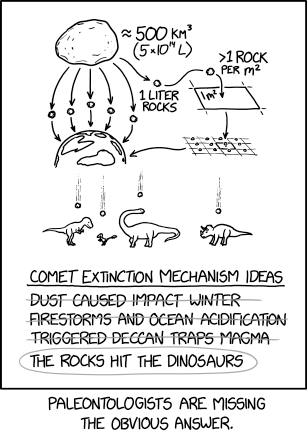Extinction Mechanisms

The Late Heavy Bombardment was followed a few billion years later by the Comparatively Light but Oddly Specific Bombardment.

The Late Heavy Bombardment was followed a few billion years later by the Comparatively Light but Oddly Specific Bombardment.
Around 66 million years ago there was a mass extinction event responsible for the extinction of all non-avian dinosaurs. This is why there are no more dinosaurs (except for birds!) There have been a number of explanations for this, but most currently accepted explanations center on the Chicxulub impact, in which a large asteroid (the comic suggests it was a comet) hit the Earth. The exact mechanism for the extinction caused by this event, however, is not clear. The comic suggests three possibilities: impact winter caused by dust released from the impact, firestorms along with ocean acidification from acids generated by the impact, and the enhanced eruption of volcano(es) in the Deccan Traps region in India. Here all three possibilities have been crossed out and a fourth one, "the rocks hit the dinosaurs," is circled as the correct answer.
The argument is that the comet had a volume of 500 km3 (10 km diameter), or 5×1014 L. Earth has a surface area of around 500 million km2, or 5×1014 m2. The idea is that the comet broke up into liter-sized rocks, so that there were sufficient of these to fall, on average, one on every square meter of surface. Somehow, these rocks managed to fall in a distribution such that they directly hit each of the dinosaurs, but presumably did not hit the other forms of life that did not go extinct. It is unclear how such a breakup or scattering might have occurred – a body that passes within Earth's Roche limit will eventually break up into a ring, but this limit is generally a single-digit multiple of the planet's radius, so an object on an inbound collision course would only experience high tidal forces for a matter of minutes before impact.
The title text refers to a hypothetical event early in Earth's history, ironically known as the Late Heavy Bombardment, in which a number of asteroids struck the Earth and other terrestrial planets around 4 billion years ago. The mass extinction event of 66 million years ago is then referred to as the "Comparatively Light but Oddly Specific Bombardment", presumably because it isn't as heavy as the LHB, but oddly specific in its targets.